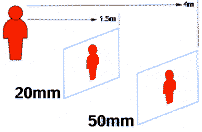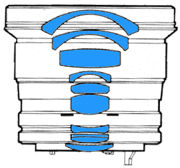New FD 20mm f/2.8 Lens
Its lens speed of f/2.8 is the fastest among 20mm lenses (Perhaps the Zuiko 21mm
f2.0 is considered a stop brighter but it is at 21mm). The use of glass with a high
refractive index corrects aberrations such as spherical, curvature of field and also
astigmatism.
|
|
|
|---|
Despite its fast speed and other strong features, the 20mm remains compact and light weight for utmost portability. It is an very interesting lens and often unrated by many photographers mainly due to its first exaggeration of perspective as compared with the common wide angle vision of 28mm or 35mm. This lens is perhaps the first lens that actually portrays a feel of the exciting world of Ultra-wideangle photography. In other words, you have to see the image produced by such a focal length through the SLR's viewfinder to see what I meant. Its most significant difference, however, is a maximum aperture of f2.8, one stop faster than that of the 17mm which at times can be of significant difference for available light photography.
 |
Obviously, the true sense of the lens is its great depth-of-field that can be generated with even a moderate aperture selection to ensure for broad coverage of subject in focus. |
The features of the FD 20mm f/2.8 wide-angle are much like those of the FD 17mm f/4, but with some important differences. Both are super wide-angle lenses, but the 20mm has a 10° narrower angle of view-94° compared with 104°. Also, the 20mm is about 55 grams (almost 2 oz.) lighter.
First, let's illustrate the relationship of angle of view to picture-taking. We'II use the standard 50mm lens as a point of comparison. The angle of view of a 50mm lens is 46°. Thus, the angle of view of the 20mm (94°) is slightly more than double. What is most important is that the 20mm takes in about four times the picture area.
 |
The easiest way to understand this is to look in a viewfinder, first with a 50mm lens and then with a 20mm. For example, if you stood about four meters (about 13.1 ft.) from a subject using a 50mm lens (with the camera held vertically), you would record the same size image as at 1.5 meters (4.9 ft.) with a 20mm lens. With a 17mm lens you could shoot as close as 1 meter (39 in.) to record an image the same size as the one recorded with the 50mm lens. |
With only a slightly longer focal length than the 17mm and a full stop more speed, the 20mm f/2.8 is a lens that is very useful for shooting in tight quarters under poor lighting conditions. It is in a small room with a fairly low level of illumination that a lens like the 20mm f/2.8 reveals its strongest attributes. A fast f/2.8 maximum aperture makes viewing and focusing much easier than with slower lenses. Thus with the 20mm you give up 10° in angle of view compared to the 17mm but gain an all important one -stop in lens speed. But the wide angle of view and high speed are not only suited for indoor shooting.
At only 305 grams, the FD 20mm f/2.8 is surprisingly light. In fact, at 55 grams lighter than the 17mm, it is an easy lens to carry and use. Its light weight and compact design enable you to handle it with ease. In certain situations, its deep depth of field allows you to shoot without even looking through the finder. You might, for example, be in a crowd and be forced to shoot by holding the camera over your head. Or you may want the subject to remain unaware that you are taking a picture.
An old but still very useful technique that most news photographer and photojournalists use with the 20mm lens is, first select the aperture and shutter speed combination that will give good exposure and at the same time prevents the effects of camera shake. |
Credit: Image courtesy of Allan Detrich ®. Image copyright © 2003. All rights reserved. Please respect the visual property of the contributing photographer.
 |
The distance setting should provide sufficient depth of field, covering the range over which you expect the action to take place. You can either literally shoot from the hip without raising the camera, or quickly bring the camera to your eye and shoot without focusing. The wide angle of coverage will help overcome lack of precise framing of the shot. |
 |
Specifications: |
Distance scale: (m) 0.25
(magnification 0.13X) to 3 (ft) 0.9 to 10. OO
Focusing: Helicoid
Minimum aperture: f/22 A
Diaphragm: Automatic Filter size: 72mm
Hood: BW-72
Cap: C-72
Function: Auto Aperture, Full aperture metering (AE operation when used with
ALL Canon automatic SLR cameras.
Length x max. diameter: 58mm x 76.5mm
Weight: 305g
 |
Older Version: Canon FD 20mm f/2.8 S.S.C. |
 |
Current Autofocus Version: EF 20mm f2.8 USM |
Canon EOS SLRs | Canon EF lens Resources
| Back | Main Index Page of Canon FD lenses
| Back | Main Index Page of Canon A & T Series SLR Models
| Message Board |
for your Canon
A-Series SLR camera(s)
| Message Board |
for your Canon
T-Series SLR camera(s)
| Message Board |
for your Canon
T90 SLR camera
| Message Board |
for your Canon
F-1(n) SLR camera
| Message Board |
for your New
Canon F-1 SLR camera
| Message Board | for your Canon Optics
in a shared environment
| Message Board | Specifically for Dispose or Looking for Canon Photographic
Equipment
about this
Site
![]()
Home - Photography
in Malaysia
Copyright
© 2000.
leofoo ®. MIR
Web
Development
Team.
Site
Maintainance Editors: Kaipin, Terry Carraway, Gerry, Winston,
Tom & IRwin (Dr Strangelove); Credit: Richard Yeow, general manager
of Canon Marketing for his continual support;
Mr. Philip
Chong,
who volunteered to be a Maintainer of this site; Mr. Vincent
Thian,
an AP (Associated Press) photographer for contributing
some of the great images appeared in this site; Mr CYLeow, photo-editor
of The Star newspaper for some of his images used; my nephew EEWynFoo for helping so
much of the tedious scanning works. And TO ALL THE CANON GURUS: Thank you for helping
so much with the input of so much of invaluable information at the various Canon
Message Boards. Site
created 'unfortunately again with a PowerMac.